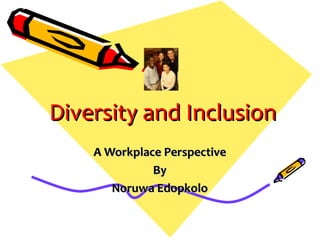Diversity And Inclusion
- 1. Diversity and Inclusion A Workplace Perspective By Noruwa Edopkolo
- 2. Program Objectives • Emphasize the value of diversity. • Eliminate misconceptions of diversity and its effects. • Improve the management of diversity. • Develop greater workplace productivity. • Enhance human relations.
- 3. Focus Areas • What is diversity? • Why is it important to understand diversity? • What are the consequences of not managing diversity • How to manage diversity?
- 4. Definition of terms What is diversity? • The fact or quality of being diverse; difference. • A point or respect in which things differ. • The ways we are different; the condition of having unique characteristics. The condition of being diverse : Variety ; especially : the inclusion of diverse people (as people of different races or cultures) in a group or organization. What is Inclusion? • The act of including or the state of being included. • Something included.
- 5. Aspects of diversity • Age ( generational differences) • Race • Gender Ethnicity • Sexual orientation • Religion. • Physical attributes etc. • Education • Job Title ,function ,skills. • Disability • Height/Weight • Marital status. • Language/Accent.
- 6. Why is it important to understand diversity? Diversity is more than just tolerating differences. It is: • respecting, appreciating, and understanding the varying characteristics of individuals. • Everyone is unique and no single person is a representative of a certain group. Stereotypes and other racial biases/prejudices are damaging to a business.
- 7. Cont.. What about “ generation?” Definition: A body of individuals born in approximately the same time period who generally share similar behaviors and attitudes. Understand that there are now four (4) generations in the workplace with different: • expectations, • motivations, • attitudes, and • behaviors. An understanding of these generational differences can equip one to handle workplace situations with increased insight.
- 8. The Four (4) Generations • Traditionalists/Veterans (Born 1922-1945) • Baby Boomers (Born 1946-1964) • Generation X (Born 1965-1982) • Millennia's/Generation Y (Born 1983-1997)
- 9. What are the generations in your organization? How they differ: • Preferred Leadership Approach. • Communication Style. Motivational Buttons. • How They Interact with Others. • Preferred Approach to Feedback. • View toward the Company. • Work Vs. Personal Life. • Desired Rewards. • Financial Behaviors. • Relationship with Technology. • Expectations.
- 10. Benefits of Understanding Generational differences: • More effective communication • less misunderstandings. • Increased recruitment and employee retention. • More effective motivational methods. • Better-formed expectations. • Increased productivity and teamwork.
- 11. Consequences of not managing diversity. • Discrimination • breeds narrow-mindedness, • impairs employee morale, • strains employee relationships, • and thus, damages productivity. Not to mention, it is illegal and costly in terms of litigation!
- 12. Group discussion What words describe the attitude to diversity in your organization? Time : 10mins.
- 13. managing diversity – The organization is diverse by default, and now it must deal with it. – Effectively managing diversity can improve organizational effectiveness – When managers commit to diversity , it legitimizes diversity effort of others. – Promoting a nondiscriminatory workplace environment – Research suggests slight differences in treatment can cumulate and result in major disparities over time
- 14. Top-management commitment and rewards for the support Of diversity are critical ingredients for the success of diversity management initiatives. Managing Diversity Effectively Makes Good Business Sense What a Diversity of Employees Provides – A variety of points of view and approaches to problems and opportunities can improve managerial decision making. – Diverse employees can provide a wider range of creative ideas. – Diverse employees are more attuned to the needs of diverse customers. – Diversity can increase the retention of valued organizational members. – Diversity is expected/required by other firms
- 15. Diversity Bias • Assumptions of Superiority – I’m better than you. • Assumptions of Correctness – This is the way it should be • Assumptions of Universality – We’re all the same. Everybody is just like me.
- 16. The Challenge of Workplace Diversity? • The challenge lies in the continuous improvement of the integration and social acceptance of people from different backgrounds. • Our differing human characteristics influence the way we think, act, interact, and make choices. • Often, these differences interfere with our ability to support, trust, and respect each other, and thus to effectively function together.
- 17. Avoiding bias • Similar-to-me effect – perceive others who are similar to ourselves more positively than we perceive people who are different • Social status effect – perceive individuals with high social status more positively than those with low social status. • Salience effect – focus attention on individuals who are conspicuously different. • Knowingly and willingly denying divers individuals access to opportunities and outcomes in an organization
- 18. summary Steps in Managing Diversity Effectively – Empower employees to challenge discriminatory behaviors, actions, and remarks – Reward employees for effectively managing diversity – Provide training utilizing a multi-pronged, ongoing approach – Encourage mentoring of diverse employees.
- 19. Action Goals • List 5 personal commitment action goal for dealing with discriminatory behavior at work? • Determine your generational differences with your colleagues, have you been sensitive to the diversity difference.



















